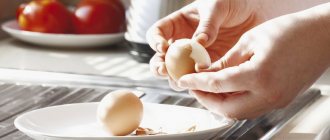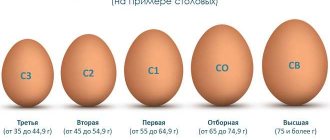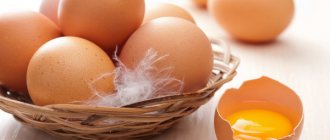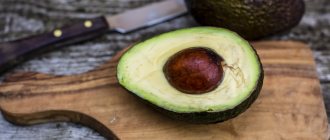04/16/2018 Maria Ivanova 2 comments
Eggs are a valuable food product that is used in every family. They are eaten as an independent dish or used as an additional ingredient in various recipes - soups, baked goods, cutlets. They buy them in dozens and use them gradually as needed. However, there are times when the shelf life is called into question. How to determine the freshness of eggs at home?
Immersion in water
This is the simplest and one of the most reliable verification methods. You need to pour cold water into a bowl or glass and place the egg there.
How to determine the freshness of eggs: the easiest way is to immerse them in water.
Depending on how it behaves, its degree of freshness is determined:
| Egg behavior | What does it mean |
| Sink to the bottom, does not float up, lies on its side | Fresh |
| Sink to the bottom, stands upright | Edible, but was demolished 7–14 days ago |
| Floats, vertically, horizontally, one end is above the surface | Edible, but already “on the verge”, it is advisable to heat treat it as best as possible, demolished 14–21 days ago |
| Floats sideways on the surface | It's spoiled, you can't eat it under any circumstances |
The test must be carried out with each egg separately. One box can contain products of different ages. This method works reliably because in stale eggs the active development of microbes or the process of rotting begins, gases are formed, and therefore the product becomes lighter.
Immersion in saline solution
There is another way to determine the freshness of eggs in water. In essence, it is no different from the previous one, although it is generally accepted that it is more accurate. You need to salt the water, then put eggs in it and, just like in the previous case, look at their behavior.
The signs are all exactly the same:
- a fully floated egg is spoiled and cannot be eaten;
- does not float up at all, lies on its side - the freshest;
- floats a little or stands upright - not perfectly fresh, but edible.
But in fact, adding salt to the liquid does not make any sense and does not affect the result. Internal processes in the product make it lighter, and it will float regardless of the composition of the water. On the contrary, the results may not be accurate enough due to the fact that the density of the liquid increases.
Cold storage
A good temperature range is 1-2 °C. Do not place eggs in containers located on the door of the refrigerator. They are unsuitable for long-term storage for two reasons.
- The eggs should not be constantly moved or shaken. This is exactly what happens when stored in containers. It is necessary to ensure a stable position.
- When you open the door of the refrigeration unit, there is a sharp change in temperature and humidity. This affects the safety and freshness of the product.
Eggs are placed on the refrigerator door for a short shelf life. For a long stay, you need to choose another place. This could be the bottom container of the refrigerator intended for fruits and vegetables. It establishes optimal conditions that ensure the correct ratio of temperature and humidity.
With a shake
Another way to check how fresh an egg is, does not involve the use of water or any additional equipment:
- The product is lightly squeezed in the palm of your hand to feel vibrations inside the shell. You don't need to press too hard, not because you might damage the egg, but because there's no point in doing so.
- Shake vigorously enough to cause the inside of the product to react to movement.
- If vibration occurs during the process, something gurgles, or you feel that something is shimmering or rolling inside - the egg is not fresh and should not be eaten.
This method is quite accurate, but can sometimes fail. For example, vibration and suspicious sounds may occur in an egg that is still edible due to shaking too much. Or, although this happens much less often, the egg has already deteriorated so much that there is nothing left to move there.
How can you tell if an egg is fresh when purchasing?
At your request, the store can bring you an ovoscope. Thanks to it, you will view the inside of the egg, the air chamber, which will allow you to understand how high-quality the product is. However, you may not need to use an ovoscope. Just use the following methods.
To check the freshness of the eggs, inspect them carefully. You have to choose a good product based on these indicators.
Ovoscope
On the shell
- If the shell has a rough surface, it is matte, and hard , then the egg is considered fresh.
- If the surface of the shell is soft and has dark spots on it , then the product is rotten.
- If the shell is shiny and has a blue tint , the egg is old and spoiled. Sometimes sellers specially rub eggs so that they have a marketable appearance. However, this should not be done, since this reduces the shelf life of the product.
- If there are eggs in the tray that have a matte surface, but the specimens with them are shiny, it means the seller mixed fresh eggs with spoiled ones.
On the shell
By smell
Many people claim that the shell of a bad egg has a specific, nasty odor. But this indicator is considered dubious, and therefore it does not always provide accurate information.
However, you can also easily use such a check. This is because eggshells tend to absorb a variety of odors. If the egg is fresh, it smells like lime. The egg is stored longer - various odors may be present on its surface.
By translucency
You can check the freshness of eggs if you shine them with a paw with a power of 100 W. It could be an ordinary flashlight.
- The transillumination method makes it possible to examine the puga. If there is no puga, then the egg is considered good. This part tends to manifest itself over time. It is necessary for a certain period of time to pass for the water to evaporate and the inside of the egg to become dense. In a dietary egg, a puga is a maximum of 0.4 cm, but in a table egg its size is no more than 0.9 cm.
- A diet egg has a uniform, dense yolk. When you shine it through, it should be visually located in the central part.
- In a table egg, the yolk is slightly to the side.
- If the yolk is located immediately next to the shell, then the product should not be eaten.
Check
Also, while watching, you will notice inclusions in the form of blood:
- If the droplets are small, then this is normal.
- When the drops are arranged in a ring, never buy such an egg.
- If blood entered the inside of the egg while it was forming, then the white will be pinkish and the yolk will have an orange tint.
Also look carefully to see if there are any dark spots inside. If any are present, it means that pathogenic microorganisms have begun to develop inside.
Shaking method
If you want to find out whether a product is fresh or not using this method, first do the following:
- Squeeze each piece until you feel a slight vibration in the inside after doing so.
- Gently shake the eggs individually so that the shells remain intact.
- If the product is not spoiled, it will not give any unusual sensations. There will be no vibration inside since the egg is very dense.
- If, after squeezing it tightly in the palm of your hand and after shaking, something starts to get loose in the inside of the egg and is thrown around, do not buy this product, as it is spoiled.
Shake
This method is popularly called “chatterbox”. Because during the process it feels as if something is moving inside the egg itself. This technique has one important drawback - with its help you will never be able to find out exactly how long the egg has been stored, or what degree of freshness it is. Thanks to this method, you will only identify those eggs that are not worth buying.
Twist the egg
This method will also be useful to you in the store when buying eggs. It's quite simple:
- Place one egg on a flat surface.
- Try to push it to make it roll.
- If the egg turns and rolls for a long time while moving, it means it is rotten.
- A fresh egg rolls smoothly, but in a very short time.
By weight
If the store has check scales, then find out the weight of the egg.
- An egg that weighs more than 75 g has a high category. “B” is printed on the shell of such an egg.
- An egg weighing a minimum of 65 g and a maximum of 75 g is considered selective.
- An egg weighing a minimum of 55 g and a maximum of 65 g is classified as 1st grade.
- An egg weighing a minimum of 45 g and a maximum of 55 g is class 2.
- An egg whose weight is no more than 45 g belongs to the 3rd century.
Weighing
When you weigh an egg, you will immediately understand whether the markings on it are correct. For example, a selected specimen has less weight, which means it is defective. The weight of the egg decreased, possibly due to drying out as the moisture in it evaporated. Let us note that the best and most balanced in terms of nutritional composition are eggs that belong to the 1st grade.
Spinning on the table
The freshness of eggs can be determined not only in water. One method is to watch it rotate. The edible product does not rotate, at most it wobbles or makes 1 slow incomplete turn. A spoiled egg will spin well and smoothly, almost like a boiled one. It will also roll for a long time and turn often.
But this method requires additional verification, especially if it is used at home. For example, using water. It may turn out that this is not a spoiled raw egg, but a hard-boiled one that accidentally fell into a container with raw ones. If a well-spinning egg sinks in water, this is most likely just such a case.
We check the quality with an ovoscope
An ovoscope is a special device used to determine the freshness of eggs by candling. A fresh canned egg should look as light as possible, the yolk should not touch the walls, move smoothly and be only slightly darker than the white. There should be no clots or darkening.
If you see spots or clots, and the yolk moves very slowly and periodically or constantly comes into contact with the shell, then the product is of poor quality. In cases where it is opaque or has a reddish coloration, the product should be discarded immediately as it is not only unfit to eat, it may be dangerous.
According to the state of the white and yolk
One of the most reliable ways to check freshness is to crack an egg. In addition to the fact that it will immediately become clear from the smell how fresh it is, and besides the fact that dark spots inside the shell are visible, the appearance of the white and yolk can tell a lot.
You need to break it onto a flat, flat surface:
- The yolk is convex, the white is viscous, collects around the yolk and does not flow - the product is more than fresh.
- The yolk is still convex, but the white has begun to spread a little - the egg has already been sitting, but it can still be eaten after heat treatment.
- The yolk is flat, and the white has become watery and flows easily - the egg is no longer fresh and it is better not to eat it. As a last resort, use it for baking, but this is also extremely undesirable.
There are other signs of freshness. To notice them, you need to carefully examine the protein. On the sides of the yolk you can see small white threads; if you don’t look closely, they are easy to miss. These are protein flagella that are woven into chalazae, egg cords. They are necessary to fix the position of the yolk.
This is important for the survival of the embryo - no matter how the egg is turned, it will be in the same position and on the warmest side, that is, on top. Chalaza may appear before the egg is fertilized, but most often occurs after. The fertilized yolk contains a small red dot, the germinal disc.
If a broken egg has these threads visible, at least on one side of the yolk, the product is very fresh, the egg was laid no more than 4 days ago. If the chalazas are not visible at all, the product has been sitting for a long time. This is due to the fact that they dissolve over time.
It is important to consider 3 points:
- The degree of freshness is not determined by the color of the yolk. It depends only on the diet of the bird that laid it. The rich yellow-orange color is typical for products from village chickens that are well fed or for eggs from poultry farms where the birds eat special feed with nutritional supplements.
- The color of the shell, brown or white, has nothing to do with the quality of the product. The only difference between them is that the light ones are easier to break. In addition, it is easier to notice a gray coating on them, which indicates that the egg is very stale.
- If you break an egg directly into a hot frying pan, you won’t be able to understand anything, since the white will curdle and will hardly spread in any case.
- By taking into account all the details of this method, it is possible to fairly accurately determine the suitability of the product for consumption.
Shelf life of eggs
The freshness of a chicken egg depends on the time of production and storage conditions.
Eggs can be divided into several types.
- Dietary - the freshest, the shelf life of which at low temperatures does not exceed 7 days.
- Canteens - 25 days at room temperature and 90 in the refrigerator.
Boiled chicken eggs can be refrigerated for up to 14 days if they are hard-boiled. And if soft-boiled, then no more than two days. Cracked and peeled - no more than three days, and broken raw - only two days.
Easter eggs dyed with natural dyes (onion peels, vegetable juices) are stored for no more than two weeks. If painted with artificial paints, the shelf life increases by another one or two days. Colorful thermal film, which does not allow air to pass through, greatly reduces freshness, these eggs should be eaten within the next three days.
And if you keep chickens, you can safely store fresh eggs for up to 3 months, in the refrigerator, of course. When buying homemade eggs on the market, even from a trusted seller, do not store them for a long time, make allowances for the fact that they have been collected for sale for more than one day.
By smell
Determining the freshness of eggs, in water and not only, is important in order to avoid food poisoning. Smell testing methods can be quite accurate, but do not always work. For example, with impaired sense of smell.
| Break an egg | Without breaking the eggs, smell the shell |
| A spoiled product will have a distinct smell of sulfur or rotten eggs. This egg cannot be eaten. Also, mold spots may be visible on the inside of the shell. | Presumably, the smell of sulfur, indicating the staleness of the product, will be felt even through it. The most unreliable method of all. |
| A fresh egg smells like lime. Leaving it for a long time will absorb the surrounding odors. |
If you can't smell the egg, but the egg is suspicious, you can ask someone else to help or let your pet smell it. Cats, dogs and other predators are unlikely to find the smell of a stale product attractive - they will either begin to imitate burying a bowl of food, or will try to leave as quickly as possible.
How to hold the product correctly
Do not neglect the expiration dates of eggs. Particular vigilance is needed in the heat, when the risk of catching an intestinal infection increases many times over. What else is worth paying attention to?
- Dislocation. Although absolutely all refrigerators are equipped with special compartments for eggs on the doors (probably in order to save space), modern scientists call this the worst place for storing eggs. Each time the door is opened, there is a vigorous shaking and an influx of warm air, to which the product is very sensitive. Cooks also agree, adding that shaking thins the egg whites. The best place to place the product is considered to be a compartment or drawer for vegetables and fruits.
- Loneliness. Eggs must be stored separately. This will prevent the absorption of “foreign” odors, as well as infection in case of contact with other raw products. Food containers, special mobile cells or “native” packaging are suitable. It is recommended to wrap boiled eggs in paper.
- Position. For storage, the egg is placed with the blunt side up. Then the yolk will move to the center and will not come into contact with the air layer.
- The washing up. Eggshells have a protective film invisible to the eye, provided by nature as a natural barrier against various infections. Therefore, it is not recommended to wipe, let alone wash eggs before storing. This should be done right before eating or cooking. Many people prefer to use a cooled soda solution for cleansing (a tablespoon of baking soda per liter of water). Keep in mind that washed eggs are stored in the refrigerator for no more than 10-12 days.
- Personal hygiene. After “contact” with the product, you must wash your hands with soap.
Checking for clearance
Usually such a check is carried out with an ovoscope, but if this is not available, any powerful light source with a directed beam will do. When exposed to light, you can see how edible the egg is.
| You can eat | Unfit for food |
| the yolk is in the center, there are no inclusions in the white, a very fresh product | a ring of blood or large and visible blood clots are visible |
| if the egg has been sitting for a while, but is still edible, there are small inclusions in the white | many large dark spots |
| there is too much air that separates the shell and the white | |
| chicken embryo |
At home, without an ovoscope, it can be difficult to illuminate an egg with a thick shell.
Visual assessment
It is difficult to determine by appearance whether an egg is fresh or not, since rotten ones have practically no signs of any kind. You need to carefully look to see if there are any cracks or powdery deposits on the egg. If you break an egg, you need to look at the white to see if there is a change in color (pink, black, green, blue). In this case, the egg should be thrown away. If the white is normal and the yolk has spread immediately, you need to smell it; if there is no strange smell, it can be eaten.
Andrei Ilyin said that Yakovleva’s son was wildly jealous of his mother’s on-screen husband
“I was vaccinated”: Petr Kuleshov decided to get vaccinated against coronavirus
Chemical-free mouthwash is easy to make at home (recipe)
Using an ovoscope
This is the same as a candling test, only using a device specially designed for this purpose, called an ovoscope. And the method for determining freshness is called ovoscoping. Ovoscopes can look different and are designed to check several eggs at once or just one. But their operating principle is identical - they illuminate the shell, even the densest one, and show the inside of the egg.
The damaged product shows:
- large blood clots;
- embryo;
- dark spots;
- blood ring;
- too wide a layer of air separating the shell from the protein.
By standard, all grocery stores must have ovoscopes available to customers before they purchase the product. Or the seller must, upon request, check the products using this device. You can also buy an ovoscope for personal use at specialized retail outlets.
Shake before use
The humorous name, however, accurately reflects the essence of the most accessible test for egg freshness. A fresh product will not give the feeling of shimmering liquid and extraneous noise - gurgling - inside the shell. The contents of a stale egg lose its homogeneity, and the center of gravity of the separated protein shifts when moving, creating the impression of a rolling ball. Gurgling sounds indicate that air has gotten under the shell and expanded the natural air chamber that each egg has.
When cooking
You can determine the freshness of eggs in water during the cooking process in the same way as before cooking.
Since it is in the water, you need to look:
- does it float up - if so, how much, if it only rises a little above the bottom and is located horizontally, can it be eaten;
- if it cracks during boiling, check the smell above the container - an unpleasant hydrogen sulfide tint indicates that the product is unsuitable for food;
- The egg lying on the bottom, even at high boiling and in very salty water, is guaranteed to be fresh.
But it's best to check the freshness before you start cooking.
Reading the markings
How to check chicken eggs for freshness before buying them in a store? Of course, learn to decipher the markings!
Buyers usually pay little attention to the small colored stamps on the shell. And you need to look at them. They can tell you even before purchasing what quality the product is in front of you.
To determine the freshness and quality of eggs, you need to pay attention to three parameters of the stamp:
- Color. The red stamp is placed on the freshest dietary products. Blue - on dining rooms.
- First character. Letter D – dietary (shelf life no more than 7 days). Letter C – tableware (shelf life up to 25 days).
- Second character. Letter B is a product of the highest category (weighing more than 75 grams). Letter O – selected (weight 65-75 g). Numbers from 1 to 3 are a category. She divides the product by size. 1 – the largest (up to 65 g), 2 – medium, third – the smallest.
According to this, the largest and freshest chicken eggs will be marked in red with the inscription DV. Further on the stamp may be the name of the manufacturer and the date of packaging.
How to distinguish a raw egg from a boiled one
The simplest and most reliable method to distinguish boiled eggs from raw ones is to spin them on the table. This is similar to determining freshness using the rotation method. A raw and edible product does not spin, it only wobbles, even if you apply force.
And the boiled one rotates for a long time, smoothly and quickly, if you spin it hard.
Freshness of boiled eggs
The method is suitable for recently boiled eggs. The longer a boiled egg sits, the easier it is to peel it and this method comes to naught.
- Fresh eggs are difficult to peel; the shell separates with the white.
- The better the shell comes off, the older the egg.
A green, gray or blue edging on a boiled egg indicates that the egg is overcooked. The egg was simply kept in boiling water for a long time.
Why are spoiled eggs dangerous?
Poisoning from stale eggs can be more dangerous to health than other household poisonings. If a healthy person with good immunity is poisoned, the consequences may only include severe dehydration after vomiting and diarrhea, as well as a feeling of weakness and stomach pain even after all the symptoms have passed. In such a situation, you should drink more water and carefully monitor your well-being. If it worsens, you should consult a specialist.
If a child accidentally eats a spoiled product, it is advisable to consult a doctor as soon as possible. A fragile body may not be able to cope with poisoning and this will lead to consequences more serious than a temporary upset stomach. The consequences will be much more serious if the egg was cooked in such a way that the yolk remained runny. This is due to the possibility of the presence of salmonella bacteria in the product.
Infection with salmonellosis most often occurs either due to the consumption of raw eggs from sick chickens, or due to the fact that the product was no longer fresh. Symptoms appear after a minimum of 6 hours and a maximum of 72 hours. Poisoning in this case is accompanied not only by vomiting, severe diarrhea and abdominal pain, but also by high fever. In some cases, in particular if a child is poisoned, this can lead to death if a doctor is not consulted in time.
The freshness of eggs must be determined by any available means. In water, by unwinding or by smell, it doesn’t matter, the main thing is that the method inspires confidence and is more or less accurate. To maintain health, it is important to prevent unsuitable food from reaching the table.











